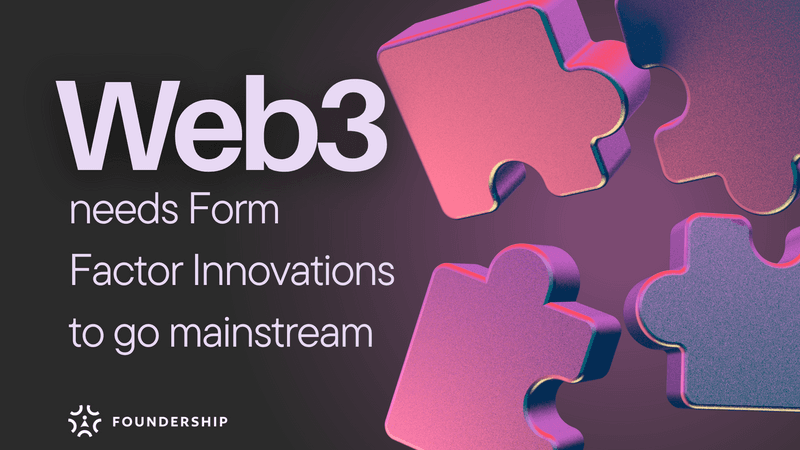Many of my friends (founders and tech folks) are scared to touch Web3 wallets and dApps! They think too much work in learning, configuring, and safeguarding to get to play Web3 dApps, DeFi and almost all things in Web3.
These folks are hands-on developers, founders of large-scale B2B/B2C startups, and have 1 to 2 decades of experience building and using software products.

Did you know that there are 90 and 100 million technology professionals globally?
The total number of professionals working specifically in Web3 technologies will likely be 50,000 to 100,000. Source Comptia.
Should we not bring the immediate 100 million tech professionals to Web3 as users of various products rather than waiting for late adopters?
Why is that not happening? My thesis: Form Factor Innovation is a key driver for any new tech innovation to go mainstream.
In Web3, we have had several Form Factor Innovations in the last 24 months, and new products will soon attract billions of users!
Let me explain what I mean by Form Factor Innovation and provide examples.
Form Factor
Form factor is a hardware aspect that defines and prescribes the size, shape, and other physical of components. A form factor may represent a broad class of similarly sized components, or it may prescribe a specific standard. It may also define an entire system, as in a computer form factor.
Definition Source - Wikipedia
In the context of software, "form factor" refers to the software application's design, structure, and user interface, as well as how users experience and interact with it across different devices and environments.
The form factor is important because it influences user experience, functionality, aesthetics, and device compatibility.
Form Factor Innovations - Web2 Examples
As my post context is Web3 and the Internet, I will focus on form factor innovations that made the Internet reach billions of people.
Let's start with the beginning of WWW, the arrival of the first stage of the Internet, progress to Web2, Mobile and now the promise of Web3 and AI—the 3 three decades, to be specific.
Personal computers made it easy for people to experience and exploit the power of computing. Plus, the graphics and user interfaces on these PCs have brought millions of non-tech users to experience the power of computers!
Imagine how much Form Factor iterations had happened to grow the market steadily.
Then came Tim Berners-Lee's Invention of WWW: World Wide Web. The Web browser that powers the Internet came in, and suddenly, the world was connected to all things on the Internet.
Was that a single stroke of success?
Nope.
Netscape Navigator, Mozilla, Chrome, and now the latest Arc Browser; every browser brought unimaginable form factor innovations that make it easy for users to learn, communicate, create, consume (info), trade (buy & sell) and store (data).
While the browser form factor came in for users to experience, the early Internet required a lot of work with dial-up access.
The latest GenZ wouldn't know what dial-up internet access is. Do check Wikipedia/ask OpenAI.
Built-in broadband, Wi-Fi and high-speed data networks just made the browser super powerful!
The world was happy with PCs, beautiful GUI, super browsers and 24/7 access to the Internet.
Then, a Form Factor Innovation happened: The feature phone made the Internet partly "mobile" on the go in developing countries. The smartphone arrived in 2007 (iPhone), followed by Android, which solved most of the gaps with Form factors for the best user experience for billions of non-tech users.
Are you getting how critical these Form-factor Innovations were for the world to be where it is now?
I can go on with more such form factor innovation like
Search
Cloud Computing
Social Media
Creator Tools
IoT (wearable, smart devices)
...
...
All these form factor innovations simplified the user experience by providing seamless access to the Internet for all things.
This took many years! Of course, innovators built products around the above form factors (hardware, software), and billions of people came to the Internet.
We all know:
Uber began with a bright idea. What if we could push a button on a smartphone and get a ride? Smartphone had built-in gps locator! Boom.
Many software innovations wouldn't have happened without the base /hardware and device Form factor being ready!
Form Factor innovations in Web3
Yes, Web3 is yet to become mainstream, but if you have been a DeGen /OG in the Web3 space for the last decade, Crypto and Web3 have come a long way.
Almost a dial-up internet type in the initial days to now Smart Accounts!
Let's dive deep. Here are the Form Factor Innovations that are already happening in Web3!
1. Wallet Simplification:
As early as last week:
Mastercard launches 'Crypto Credential,' allowing users to send and receive crypto using a username instead of a wallet address.

MetaMask, Trust wallet, OK wallet, Coinbase or many wallers have abstracted away the complexity of private keys by using mnemonic phrases.
Smart Account is arriving …already arrived
A smart account is a wallet type requiring no private keys or seed phrases. Smart contract wallets rely on code instead of private keys to secure and recover wallet information. Instead, you set who and under what conditions, users may access the wallet via smart contracts.
Safe has evolved into a smart account infrastructure provider for Ethereum users, layer-2s like Optimism and Polygon, and exchanges like Bitfinex. Safe secures over $100 billion in value across more than 7.5 million smart account addresses.
Obvious: A mobile-only smart contract wallet that enables seamless crypto transactions, leveraging the Biconomy SDK for features like gasless meta-transactions.
Disclosure: We at Foundership are advisors to Founders at Obvious Technologies.
Soon, my friends on Web2 will not have to know the complexity behind Web3 or learn a lot to start using Web3 dApps!
2. Cross-chain
Cross-chain reduces the complexity for users who want to interact with multiple blockchain networks.
The sidechain operates independently from the main blockchain and offloads transactions from the main chain, reducing congestion and lowering fees.
Parallel chains, or parachains, run alongside each other, sharing security and consensus with a central chain. Distributing the transaction load, enhancing overall network performance.
And AppChain! AppChains are optimized for the particular needs of the applications they support.
With these form factors ready for Web3, Users can engage with different blockchain networks without needing to understand the technical intricacies of each.
Developers can speed up the time it takes to market new product ideas by abstracting and simplifying cross-chain communication, side chains, and parallel chains. This allows them to build scalable, interoperable applications with better performance and user experience.
3. L2s
L2s in Ethereum, especially Rollups, are transforming user experience with increased transaction speeds and reduced costs.
BTC is witnessing a wave of L2s imagining the future for native Bitcoin holders gaining more value.
4. New Standards ERC-20, ERC-771, BEP-20, TRC-20, SPL & More
These standards have established uniform rules and protocols for creating tokens, NFts, token transfer processes, token deployment, etc.
These standards are helping developers to simplify development and offer rich interaction experiences and user-friendly apps and solutions.
5. Zero-knowledge proofs
With Zero-knowledge proofs, users no longer need to disclose sensitive and private information.
ZKPs enable transactions to be verified without revealing transaction details, ensuring data integrity and preventing tampering.
Imagine the simplification for users and developers!
I am not discussing various ZK implementations; you can get all the details online.
6. Stablecoin
Unlike other cryptocurrencies, Stablecoin makes it easy for users by removing price volatility and complexity from crypto-to-fiat conversions.
Stablecoin is also bridging TradFi and DeFi with existing systems and payments. Developers can create smart contracts with predictable and stable value transfers, reducing complexity and potential issues related to value fluctuations.
With all such Form Factors, Web3 should have been winning to bring billions of users already. But it is not yet! Why?
What are the missing Form Factors in Web3?
UX still needs to be solved! Though all the above form factors are available, we have yet to see super UX across the Web3 landscape, except for a few, like UniSwap, Coinbase Wallet, Farcaster and a few more.
Highly secure smart contracts, frameworks, and implementations are still underdeveloped in the Web3 space, which deters/will slow down mainstream adoption.
Mobile is also missing from the Web3 scene in a big way. Though there are Solana's Sage Phone, MetaMask Mobile, and a few more initiatives, we have yet to see something unique and easy that brings 100s of millions of users for Web3 mobile apps.
Web3 needs one mega-success like OpenAI did for GenAI!
Let's buidl.
Do you have a thought to share? Feel free to comment.
—
Are you building an impactful Web3 Project in DeFi, SocialFi, Infra, Gaming, DePIN, and more?
We at Foundership - Web3 Accelerator VC enable Founders to build impactful Web3 projects and startups. Find more info on www.foundershiphq.com


